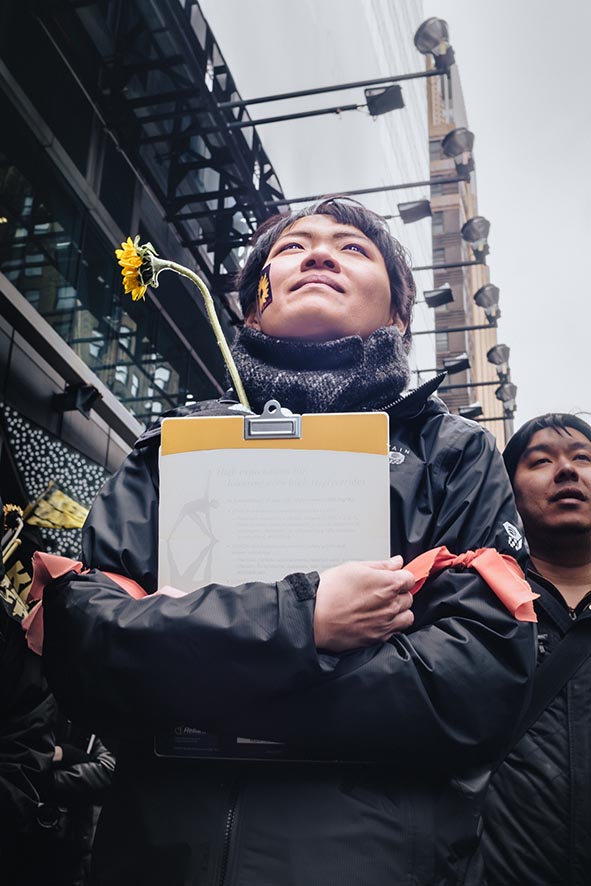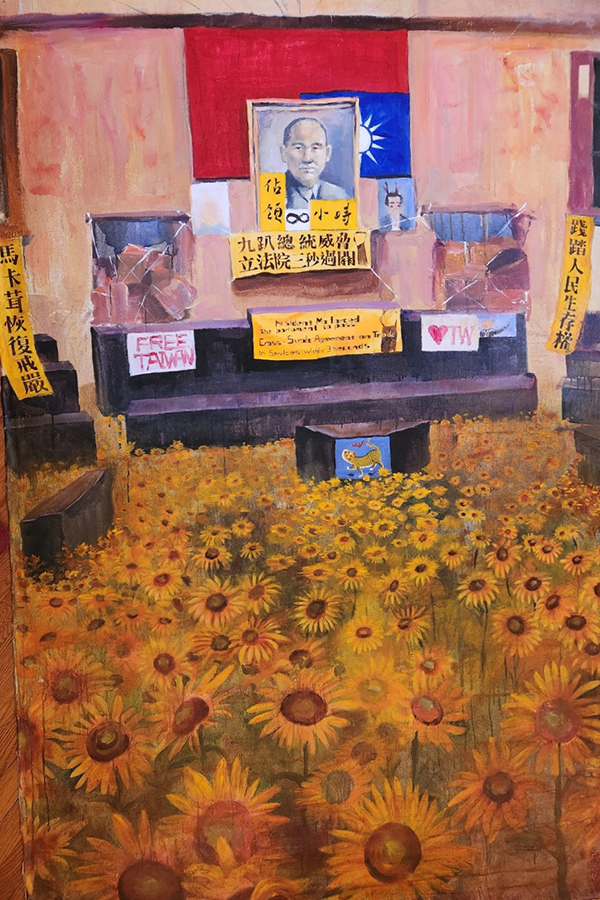 |
 |
People's Movements: Sunflower 10th Year Anniversary
by The Taiwanese American Arts Council (TAAC)
March 15 to April 15, 2024
Opening reception: Friday, March 15, 6-8 pm
Curator and artists talks: Thursday, March 21, 1-4 pm
Seminar: Saturday, March 30, 12:30-3:30 pm


In March 2014, young people led Taiwan's Sunflower Movement which in time completely reversed the course of Taiwan's foreign and domestic policy. On the 10th anniversary of the movement, we organize a program and exhibition which points out that social and political change is won through the brave spirit and effort of the movement leaders and the people -- not awarded as a lucky accident. This exhibition will involve approximately 12 artists celebrating peoples' political movements --largely youth-led -- that took place around the world circa 2014. We select 5 movements: the Sunflower Movement, the Arab Spring, the Chilean Winter, the Ukrainian Euromaidan movement, and Hong Kong's umbrella movement -- all of approximately the same era as Taiwan's Sunflower movement -- to which artists will respond.
First among them, of course, is Taiwan's Sunflower Movement in which students and other youth occupied Taiwan's legislative body in protest of the plan by ruling government (that of Ma Ying-Jeou) to strengthen trade ties with China. The Sunflower Movement was successful in blocking the proposed legislation, and led to many of its participants eventually entering formal political life and thus rejuvenating Taiwan's political culture. It's tenth anniversary will be on March 18, 2024.
Other movements to be celebrated will be Hong Kong's Umbrella Movement, which took place between 26 September and 15 December 2014 -- so 2024 will also mark the 10th anniversary of this movement. Led by Hong Kong youth, this movement was sparked by China's proposed changes to Hong Kong's electoral system -- changes that the movement unsuccessfully opposed and were later imposed unilaterally by the government in Beijing. However, this movement was resurrected on its fifth anniversary in 2019 to protest the bill enabling extradition to China -- and trial there -- of residents of Hong Kong. Beijing eventually imposed this bill on Hong Kong, further eroding the special status of Hong Kong in violation of the 50-year special administrative status of Hong Kong negotiated by the United Kingdom and China in 1997. However, this exhibition will glorify the spirit of public self-sacrifice exemplified in Taiwan's Sunflower Movement, and in evidence in each of these popular movements.
Some element of the Arab Spring will be included in this exhibition. While that movement took place in several Arab countries -- with varying degrees of success -- in the early 2010's. The Arab Spring started in Tunisia, and then spread to Egypt, Libya, Yemen, Syria, and Bahrain. In Egypt, Libya, Yemen, and Tunisia, rulers were deposed. Protests took place across the Arab world, most particularly in Morocco, Iraq, Algeria, Lebanon, Jordan, Kuwait, Oman and Sudan. All these were movements by youth in opposition to authoritarianism and in pursuit of democracy as well as a brighter economic future, and so fit the theme of this exhibition. While 2024 will be the 12th or 13th anniversary of this movement (depending on which country one looks at), it deserves to be included in this exhibition because of its aims. It is hoped to examine more carefully the Arab Spring as it took place in Tunisia (where it was successful).
Numerous political movements in South and Central America were youth-led protests. Perhaps one of the most notable was that in Chile in 2011 to 2013. Known as the Chilean Winter, it was a student-led protest against the poor for-profit educational system -- especially the post-secondary educational system -- extant in Chile at that time which tended to perpetuate Chilean class structure because the children of the very rich had adequate educational choices, but not the children of middle-class families. This system dated to the dictatorship of General Augusto Pinochet, who was not more benign than General Chiang Kai-Shek in Taiwan. In both Taiwan and Chile, the transition to democracy took place peacefully -- without a revolution -- while political movements such as those discussed herewith fine-tuned that democracy.
The youth movements in Ukraine were known as the Euromaidan or Pomvrancheva revolution. The movement is named after Maidan Nezalezhnosti (Independence Square) in Kiev, one of the first sites of demonstration on 18 February 2014; the protestors at one point also attempted to occupy the legislative branch. Unlike with the Sunflower Movement in Taiwan, armed police stymied this move, killing, wounding or arresting numerous protestors. The achieved aim of the Euromaidan movement was to topple President Yanukovych whom the protestors considered too close to Russia. Yanukovych had negotiated an agreement for Ukraine to join the EU, then declined to do so in favor of closer ties with Russia -- an echo of the closer ties with China advocated by Ma Ying-Jeou in Taiwan.
Ultimately, the success of the Euromaidan revolution, which was supported by speakers of Ukrainian and opposed by Ukrainian speakers of Russian, emboldened Russia to seize the Crimean Peninsula, a Russian-speaking area of Ukraine. A variety of artists from the region will make and display art commenting on the Euromaidan revolution in Ukraine.
This exhibition thus celebrates youth-led popular movements of approximately 10 years vintage and simultaneously highlights both the similarities and differences between them. Social and political change is never straightforward and compartmentalized, let alone complete -- which is why we have chosen a variety of such movements.
About TAAC: The Taiwanese American Arts Council (TAAC) fosters awareness of Taiwanese American art within the broader community by coordinating, sponsoring, and presenting high quality programs in all disciplines of art, and encourages cross cultural exchange between Taiwanese Americans and others. From 2014 to 2023, TAAC has organized and presented numerous multi-disciplinary arts programs, partnered with various art organizations, and utilized digital media to realize the goal of promoting Taiwanese American artists and art professionals in the US. TAAC hopes to build bridges between communities, nationally and internationally, through art and culture to deepen our senses of beauty, inspiration, and empathy.
About the project curator: Luchia Meihua Lee
Ms. Luchia Meihua Lee lives in New York, and travels between Ireland and Taiwan for her research. She is a distinguished independent curator of contemporary art, and an art historian of Medieval Manuscripts and insular art. She is the founding Executive Director of the Taiwanese American Arts Council. Ms. Lee has successfully curated many significant exhibitions and events at museums, art organizations, and galleries. She is deeply involved in the contemporary art scene in the New York metropolitan area. She was Director and Chief Curator of the Exhibition Department of the National Taiwanese Museum of Art, Cultural Specialist at the Council for Cultural Affairs in Taiwan, and curator at the Chinese Information and Cultural Center Taipei gallery in New York City. Her exhibitions have received international acclaim from leading media venues including the New York Times and Wall Street Journal. She is a committee member and art consultant of numerous art organizations, and has served on many art juries.